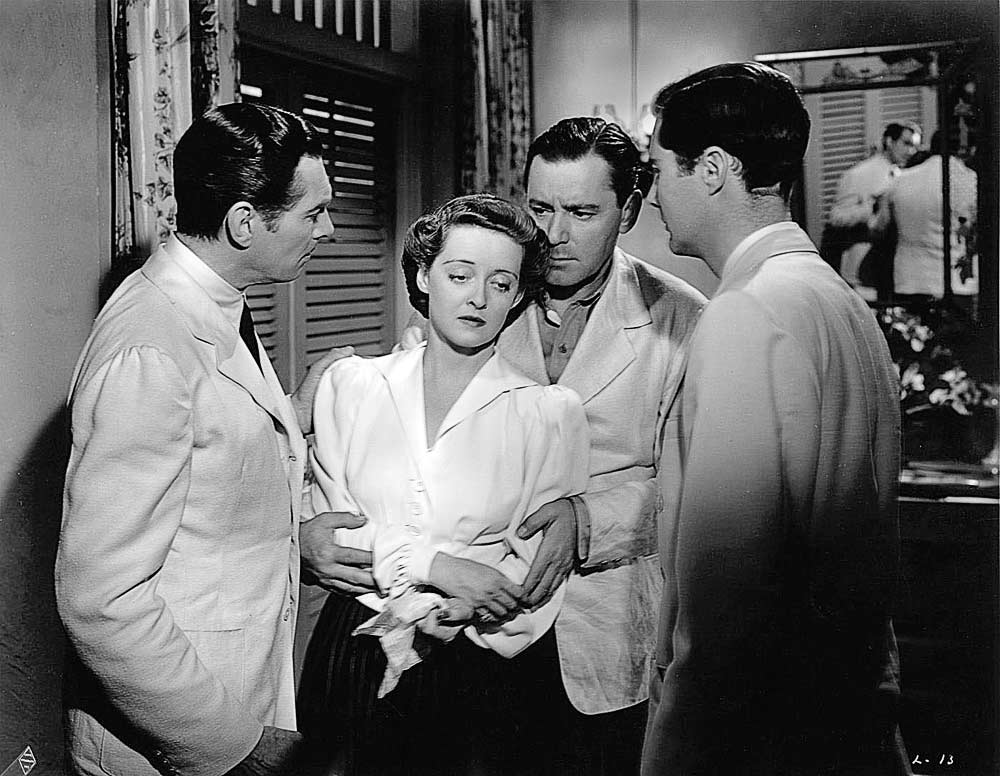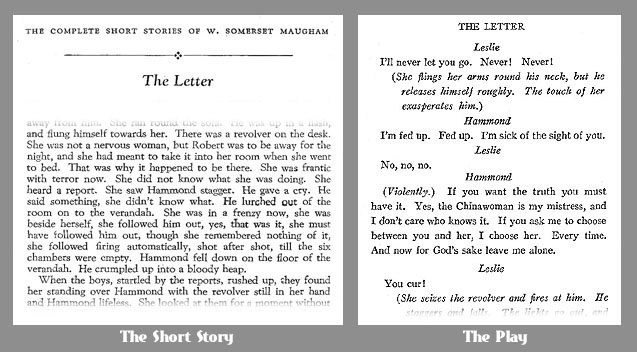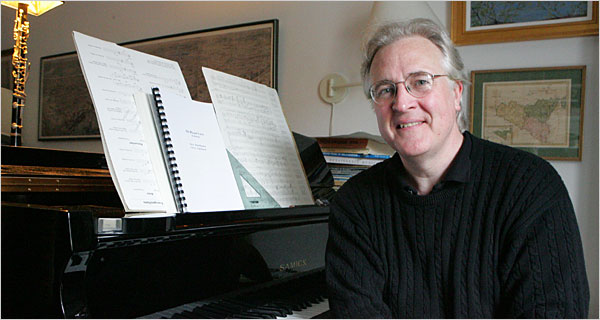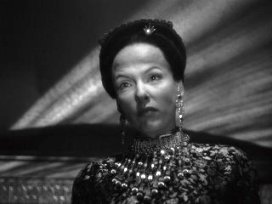“A negative judgment gives you more satisfaction than praise, provided it smacks of jealousy.”
Jean Baudrillard, Cool Memories
TT: Men (and women) at work (VI)
Last week Paul Moravec and I spent four days preparing a workshop performance of the first six scenes of The Letter, our Somerset Maugham opera-in-progress, at a midtown rehearsal studio. On Wednesday morning we recorded all six scenes at the New York headquarters of the Santa Fe Opera, after which we performed them for a small invited audience of opera and theater professionals. Then, on Thursday evening, we gave a second performance, this time at an Upper East Side cocktail party thrown on behalf of Santa Fe Opera by two longtime friends of the company who live in the biggest townhouse I’ve ever seen. (It looks like the set of Holiday, only in color.) We presented twenty minutes’ worth of excerpts from The Letter to an audience of a hundred-odd well-heeled opera buffs, augmented by a sprinkling of singers and other music-business types.
 When I say “we,” of course, I don’t mean “Paul and I.” Santa Fe engaged eleven professional singers, flew in one of of its staff accompanists, and turned the lot of them over to us for the week. They did the performing. All we did was rehearse them, then introduce the opera on Wednesday afternoon and Thursday night. One of the singers with whom we worked, James Maddalena, is well known in the opera world (he created the title role in John Adams’ Nixon in China). The others were up-and-comers whose names will likely be unfamiliar to you–though I doubt they’ll stay that way. All of them, Jim very much included, worked incredibly hard at learning The Letter, then sang it with the utmost sympathy and comprehension. I don’t care for laundry lists, but sometimes they’re unavoidable, and Paul and I are grateful beyond words to Jim, Jennifer Aylmer, Jon-Michael Ball, Jeffrey Behrens, Benjamin Bloomfield, David Giuliano, Stephen Hartley, Alex Mansoori, Kelly Markgraff, Alex Richardson, and Rosalie Sullivan–as well as to Kirt Pavitt, our pianist, who had only a few days to prepare Paul’s complicated score, yet somehow managed to pull it off. No matter who performs The Letter in the future, Paul and I will never forget the twelve talented men and women who first showed us what we had wrought.
When I say “we,” of course, I don’t mean “Paul and I.” Santa Fe engaged eleven professional singers, flew in one of of its staff accompanists, and turned the lot of them over to us for the week. They did the performing. All we did was rehearse them, then introduce the opera on Wednesday afternoon and Thursday night. One of the singers with whom we worked, James Maddalena, is well known in the opera world (he created the title role in John Adams’ Nixon in China). The others were up-and-comers whose names will likely be unfamiliar to you–though I doubt they’ll stay that way. All of them, Jim very much included, worked incredibly hard at learning The Letter, then sang it with the utmost sympathy and comprehension. I don’t care for laundry lists, but sometimes they’re unavoidable, and Paul and I are grateful beyond words to Jim, Jennifer Aylmer, Jon-Michael Ball, Jeffrey Behrens, Benjamin Bloomfield, David Giuliano, Stephen Hartley, Alex Mansoori, Kelly Markgraff, Alex Richardson, and Rosalie Sullivan–as well as to Kirt Pavitt, our pianist, who had only a few days to prepare Paul’s complicated score, yet somehow managed to pull it off. No matter who performs The Letter in the future, Paul and I will never forget the twelve talented men and women who first showed us what we had wrought.
Workshopping The Letter gave us a chance to hear what the score sounds like when performed by real singers–and to talk to those singers about how it feels to perform the opera. Theater is an empirical art form: it’s about what works. If an opera doesn’t work for the people who perform it, it won’t work for the people who watch it. Hence our interest was mainly in practical matters. What parts of the score are particularly difficult to learn? Are the vocal lines well written for the voice? Do the words sit comfortably on the tongue? These were some of the questions we brought with us into the studio, and by the time everybody went home on Thursday night, Paul and I had learned many important things about the score as it stands now. He made a considerable number of small but significant changes on the spot–lowering high notes, raising low notes, inserting rests to add dramatic punctuation at key moments–and I did the same to the libretto.
Here’s an example of what we did. In Scene Two, Leslie Crosbie, the star of The Letter, asks Robert, her cuckolded husband, “Is he…is he still there?” The “he” in question is the corpse of Geoff Hammond, whom the pistol-packing Leslie has just filled with lead. “No, I had the body taken away,” Robert responds in the draft of the scene that Paul set. But as soon as he heard Kelly Markgraff sing that line to Jen Aylmer at the first rehearsal, he told me, “It’s not coming through clearly. Can you think of a crisper-sounding line?”
“Something with a p or t in the middle?”
“Yeah, something like that. Something that pops. But I don’t want to change the rhythm of the vocal line. I like it the way it is. Can you make the new words fit what I’ve written?”
I considered the problem for a moment, running over the scansion of the line in my head: DUM da-da-da DUM-da da-da-da-DUM. Then I scribbled an alternate version into my score: “No, I told the men to take him away.”
“Does that work?” I asked Paul.
“I think so,” he said. “Kelly, would you try singing this line instead?”
Kelly sang it, Paul wrote the line into his score, and that was that.
 This exchange says a lot about what a librettist does. His job is, above all, to make the composer more effective. “There is a great satisfaction in building good tools for other people to use,” Freeman Dyson wrote in Disturbing the Universe. That’s how I feel about my libretto for The Letter: I see it not as an independent art object but as a tool, an opera-shaped vessel into which Paul is pouring his music. And it’s his music, not mine, which means that at the end of the day, Paul is by definition the senior partner in our collaboration. Neither one of us is shy about making suggestions–we’ve talked over every page of the score, often in excruciatingly niggling detail–but he has to feel comfortable with my words in order to do his best work, and so on the rare occasions when we have a disagreement about some aspect of the libretto that can’t be resolved through discussion, I always do what he wants.
This exchange says a lot about what a librettist does. His job is, above all, to make the composer more effective. “There is a great satisfaction in building good tools for other people to use,” Freeman Dyson wrote in Disturbing the Universe. That’s how I feel about my libretto for The Letter: I see it not as an independent art object but as a tool, an opera-shaped vessel into which Paul is pouring his music. And it’s his music, not mine, which means that at the end of the day, Paul is by definition the senior partner in our collaboration. Neither one of us is shy about making suggestions–we’ve talked over every page of the score, often in excruciatingly niggling detail–but he has to feel comfortable with my words in order to do his best work, and so on the rare occasions when we have a disagreement about some aspect of the libretto that can’t be resolved through discussion, I always do what he wants.
What has been most striking about the process of writing The Letter, at least to me, is how infrequently the two of us disagree about anything at all. This is partly because we discussed the opera time and again for several months before I started writing the libretto, but even more because we are, aesthetically speaking, on the same page. We’re so closely in sync, in fact, that we ran last week’s rehearsals jointly. It wasn’t something we planned in advance–it simply happened that way.
 Our personalities, however, are quite different, and to some extent the public aspect of our collaboration reflects that difference. Paul is a serious, soft-spoken person who sounds like an artist when he talks. I, on the other hand, come across more like a newspaperman (or a jazz musician) than an aesthete, and I suspect that some of the people I’ve been meeting in the opera world have found me to be rough around the edges. Paul, by contrast, is so gentlemanly that his zany streak isn’t immediately apparent to those meeting him for the first time. I’m sure that some of the singers who performed The Letter for us last week found it intimidating to work with a Pulitzer Prize-winning composer–that is, until Paul strolled into the studio, sat down at the piano, and started singing “Sexy Sadie” in his very best John Lennon accent. Everybody loosened up pretty quickly after that.
Our personalities, however, are quite different, and to some extent the public aspect of our collaboration reflects that difference. Paul is a serious, soft-spoken person who sounds like an artist when he talks. I, on the other hand, come across more like a newspaperman (or a jazz musician) than an aesthete, and I suspect that some of the people I’ve been meeting in the opera world have found me to be rough around the edges. Paul, by contrast, is so gentlemanly that his zany streak isn’t immediately apparent to those meeting him for the first time. I’m sure that some of the singers who performed The Letter for us last week found it intimidating to work with a Pulitzer Prize-winning composer–that is, until Paul strolled into the studio, sat down at the piano, and started singing “Sexy Sadie” in his very best John Lennon accent. Everybody loosened up pretty quickly after that.
Even though we appear to be ill sorted, Paul and I are birds of a feather when it comes to artistic matters, which may help to explain why we’re not planning to make any drastic changes to the first six scenes of The Letter now that we’ve heard them performed. As the saying goes, operas aren’t written, they’re rewritten, yet this one has turned out so far not to need all that much rewriting. Details, yes–we’re sweating those–but it’s starting to look as though we’d already gotten most of the big things right by the time we brought The Letter into the studio. Paul and I wanted to write an “audience piece,” a tradition-based opera that would excite mainstream audiences, and judging by the enthusiastic response of the two groups who heard it last week, we seem to be well on our way to doing so. Hard-nosed professionals were present at both of those performances, too, and their comments were equally enthusiastic and encouraging. A playwright–no names, but you’d probably recognize his–came to the first run-through, and when it was over, Paul asked if he had any “notes,” which is backstage talk for “suggestions.” To my astonishment, he replied, “My only note is more. Don’t change anything. You have a winner here.” (In case you’re wondering, I’ve never reviewed any of his plays in The Wall Street Journal.)
Two especially interesting people came to the Thursday-night performance. One, believe it or not, is a member of the Singapore Club, in which Scene Five of The Letter is set. The scene opens with a drinking song performed by the clubmen, and I was amused by a comment made to me later in the evening by the real-life clubman: “What time does this scene take place? You have the characters drinking whisky, but in Singapore we don’t start drinking whisky until sunset. Before then, it’s gin.”
I laughed. “Not to worry,” I said. “The time is late afternoon. And you’re not going to believe this, but the very next line that comes after the chorus we did tonight is Ah, counselor! Would you like to fire the sunset gun?”
“I think that will pass muster,” he replied.
As if that weren’t unlikely enough, the next person I met was Melanie Wyler, the daughter of William Wyler, who directed the 1940 film version of The Letter. I nearly fell down.
 “I’m honored to meet you, ma’am,” I told her, resisting the impulse to ask for her autograph. “Were you surprised when the Chinese woman started singing?” (In Maugham’s 1927 play and Howard Koch’s 1940 screenplay, the Chinese mistress of Leslie’s lover does not speak English and never says a word.)
“I’m honored to meet you, ma’am,” I told her, resisting the impulse to ask for her autograph. “Were you surprised when the Chinese woman started singing?” (In Maugham’s 1927 play and Howard Koch’s 1940 screenplay, the Chinese mistress of Leslie’s lover does not speak English and never says a word.)
“I was glad to hear from her!” she replied. “And I loved your opera. I can’t wait to see it in Santa Fe.”
“Me, neither,” I said.
So…what next? Plenty. I’ve still got a book to finish, not to mention my regular reviewing duties at The Wall Street Journal. I’ll be going to a press preview of Caryl Churchill’s new play on Thursday, then flying to Boston to see Alvin Epstein in The Tempest on Sunday. Never a dull moment around this shop, in other words. But I did make a point of giving myself some time off over the weekend. I went to see Be Kind Rewind with a friend on Saturday night, and I spent Sunday curled up on the couch reading Patrick O’Brian, listening to Aaron Copland and Donald Fagen, and talking to Mrs. T on the phone (she drove back to Connecticut on Friday after attending the Thursday-night performance).
 Mostly, though, I spent the day marveling at the improbable fact that at the age of fifty-two, I’ve somehow metamorphosed into a librettist whose first project is in the process of being produced by one of the best-known opera companies in the world. Paul Hindemith and Igor Stravinsky conducted at Santa Fe. Kiri Te Kanawa and Bryn Terfel made their American debuts there. Thomas Adés, Peter Lieberson, Tobias Picker, and Bright Sheng were all commissioned to write operas that were performed there. And now…me.
Mostly, though, I spent the day marveling at the improbable fact that at the age of fifty-two, I’ve somehow metamorphosed into a librettist whose first project is in the process of being produced by one of the best-known opera companies in the world. Paul Hindemith and Igor Stravinsky conducted at Santa Fe. Kiri Te Kanawa and Bryn Terfel made their American debuts there. Thomas Adés, Peter Lieberson, Tobias Picker, and Bright Sheng were all commissioned to write operas that were performed there. And now…me.
Paul, unlike me, is used to this sort of thing. One of his pieces, Songs of Love and War, was performed at Carnegie Hall the night before the first run-through of The Letter. But I have a sneaking feeling that when I stand in the wings of the Crosby Theater next August, getting ready to take my bow and checking to make sure that my fly is zipped, I’ll still feel more like an actor who’s playing the part of a librettist, waiting for the director to say, “All right, everybody, that’s it for today. See you first thing tomorrow morning. Oh, yes, Terry–would you please brush up on your lines?”
TT: Almanac
“You do not become a critic until it has been completely established to your own satisfaction that you cannot be a poet.”
Théophile Gautier, preface to Mademoiselle de Maupin
TT: Cat, freshly skinned
In this morning’s Wall Street Journal I review two New York shows, the all-black Broadway revival of Tennessee Williams’ Cat on a Hot Tin Roof and the New York premiere of Sarah Ruhl’s Dead Man’s Cell Phone. Here’s a sample.
* * *
 If you want to behold a great actor giving of his very best, the show to see is “Cat on a Hot Tin Roof.” James Earl Jones has turned his back on Broadway in recent years–his last appearance there since the 1987 premiere of “Fences” was in a short-lived 2005 revival of “On Golden Pond,” a synthetic weeper that was unworthy of his towering talent–and so it is a pleasure to welcome him back to town in a role that puts him to the test. Needless to say, Mr. Jones plays Big Daddy, the cancer-ridden plantation owner whose greedy children can barely wait to gobble up his estate, and watching him tear through that giant-sized part is like standing in the path of a cannonball. Alas, you’ll have to pay a high price for the privilege of seeing Mr. Jones strut his stuff, because much of the rest of this unfortunate production borders at times on the downright amateurish.
If you want to behold a great actor giving of his very best, the show to see is “Cat on a Hot Tin Roof.” James Earl Jones has turned his back on Broadway in recent years–his last appearance there since the 1987 premiere of “Fences” was in a short-lived 2005 revival of “On Golden Pond,” a synthetic weeper that was unworthy of his towering talent–and so it is a pleasure to welcome him back to town in a role that puts him to the test. Needless to say, Mr. Jones plays Big Daddy, the cancer-ridden plantation owner whose greedy children can barely wait to gobble up his estate, and watching him tear through that giant-sized part is like standing in the path of a cannonball. Alas, you’ll have to pay a high price for the privilege of seeing Mr. Jones strut his stuff, because much of the rest of this unfortunate production borders at times on the downright amateurish.
The amateur-in-chief is Terrence Howard, the erstwhile star of “Hustle & Flow,” who is making his stage debut–not his Broadway debut, mind you, but his stage debut–in the role of Brick, Big Daddy’s favorite son. Mr. Howard is the latest in a long line of inexperienced innocents from Hollywood who have been offered up as burnt sacrifices to the gods of the box office, and the best I can say about his vain attempt to make an impression is that he must have had a lot of nerve to think that he could get away with sharing a curtain call with Mr. Jones….
So far as I know, this is the first all-black professional production of “Cat on a Hot Tin Roof,” and it’s easy to imagine how well such a concept might have worked had it been executed by a first-rate director. Instead we get Debbie Allen, whose experience at the helm of various sitcoms and musical comedies did not prepare her for the challenge of making sense out of a grossly overwritten melodrama whose verbal extravagance approaches the operatic. Ms. Allen’s way of putting a black spin on “Cat” runs more to such condescendingly on-the-nose directorial details as having a saxophonist wander across the stage at the start of each act, playing hot licks in order to reassure the audience that this production will be racially correct….
Sarah Ruhl writes whimsical, ironic plays about incredibly irritating people. They make me queasy, but her many fans evidently have stronger stomachs. Ms. Ruhl is American theater’s flavor-of-the-month, a playwright whose work is produced all over the country and reviewed with a hushed respect that I once found utterly inexplicable. Then I figured it out: Ms. Ruhl is an arrant sentimentalist who is embarrassed to admit it, so she covers up her old-fashioned tearjerking with a thick sauce of postmodern trickery and tweeness, thus making it palatable to would-be hipsters who are too cool to whip out their hankies….
* * *
Read the whole thing here.
TT: Almanac
“I shall christen this style the Mandarin, since it is beloved by literary pundits, by those who would make the written word as unlike as possible to the spoken one. It is the style of all those writers whose tendency is to make their language convey more than they mean or more than they feel, it is the style of most artists and all humbugs.”
Cyril Connolly, Enemies of Promise
CAAF: Marianne Moore critiques your poems… finds them wanting
From Rachel Cohen’s A Chance Meeting:
After they had been friends for six years, [Elizabeth] Bishop sent Moore a new poem, “Roosters”–“At four o’clock / in the gun-metal blue dark / we hear the first crow of the first cock.” Bishop described her roosters “marking out maps like Rand McNallys” with: “glass-headed pins, / oil-golds and copper greens, / anthracite blues, alizarins.” Marianne Moore and her mother were so upset by “Roosters” that they stayed up until three o’clock in the morning rewriting it, taking out everything that smacked of vulgarity, particularly a most objectionable reference to a “water-closet.” Bishop kept the poem as she had written it, but she and Moore remained close friends–testament to how loyal and sure they both were.
In his introduction to One Art, a collection of Bishop’s (amazing) letters, Robert Giroux observes that Moore (and her mother) even changed the title of “Roosters”, noting parenthetically, “their choice was ‘The Cock’.”
Rewriting of “Roosters” aside, Moore, it should be noted, was an early and important champion and mentor of Bishop’s. She also sat on a panel that awarded Sylvia Plath a first prize in a poetry contest while Plath was at Smith. Yet, a few years later, when Plath sent her a group of poems and requested a reference for the Saxton grant (Moore had previously written a reference for Plath’s husband Ted Hughes), Moore was less supportive. As Anne Stevenson writes in her biography of Plath, Bitter Fame:
In July, to Sylvia’s surprise and keen distress, Miss Moore sent her in reply what Sylvia saw as “a queerly ambiguous spiteful letter… ‘Don’t be so grisly,'” she commented; “you are too unrelenting.'” And she added “certain pointed remarks about ‘typing being a bugbear.'” Sylvia concluded that Miss Moore was annoyed because she had sent carbon copies instead of fresh top sheets. That seems unlikely. While Marianne Moore usually admired Ted’s work, she never warmed to Sylvia’s, disliking the early traces of the very elements that later were to carry her to fame: macabre doom-laden themes, heavy with disturbing colors and totemlike images of stones, skulls, drownings, snakes, and bottled fetuses — hallmarks of Sylvia’s gift.
I will forever love “Don’t be so grisly!” as a remark to Plath.
RELATED: Marianne Moore’s suggestions for the naming of a new model of Ford, submitted in 1955. Alas, the car company didn’t pick The Utopian Turtletop, The Mongoose Civique orThe Turcotingo, and went with the Edsel instead.
CAAF: Loose notes
“Do
You still hang your words in air, ten years
Unfinished, glued to your notice board, with gaps,
Or empties for the unimaginable phrase–
Unerring Muse who makes the casual perfect?”
Robert Lowell, “For Elizabeth Bishop 4”
CAAF: The dream that came through a million years, that lived on through all the tears …
Terry’s Almanac from this morning reminds me of this observation by John Ruskin about the Greeks, “… there is no dread in their hearts; pensiveness, amazement, often deepest grief and desolation, but terror never. Everlasting calm in the presence of all Fate, and joy such as they might win, not indeed from perfect beauty, but from beauty at perfect rest.”
Jane Harrison uses that quote in Prolegomena to the study of Greek Religion, which was first published in 1903. In her introduction, Harrison argues that our understanding of Greek religion “is an affair mainly of mythology, and moreover of mythology as seen through the medium of literature.”
She continues:
This habit of viewing Greek religion exclusively through the medium of Greek literature has brought with it an initial and fundamental error in method–an error which in England, where scholarship is mainly literary, is likely to die hard. For literature Homer is the beginning, though every scholar is aware that he is nowise primitive; for theology, or–if we prefer so to call it–mythology, Homer presents, not a starting-point, but a culmination, a complete achievement, an almost mechanical accomplishment, with scarcely a hint of origines, an accomplishment moreover, which is essentially literary rather than religious, sceptical and moribund already in its very perfection. The Olympians of Homer are no more primitive than his hexameters. Beneath this splendid surface lies a stratum of religious conceptions, ideas of evil, of purification, of atonement, ignored or suppressed by Homer, but reappearing in later poets and notably in Aeschylus.
It’s a fascinating book, and even if I weren’t interested in her topic, Harrison’s writing style alone would make me swoon. If you’re at all interested in Greek mythology and haven’t read this one yet, it’s worth searching out (Google books has it). I first learned about it thanks to a comments thread here.
